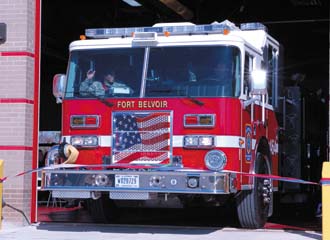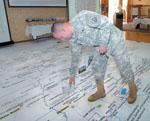Army Post Develops Disaster Management Strategies
 |
Fort Belvoir Garrison Commander Col. John J. Strycula, USA, right, and Command Sgt. Maj. Gabriel Berhane, USA, left, drive a new fire engine through a ribbon, opening the Fort Belvoir North Area’s new Emergency Services Center in December 2010. Photo by Travis Edwards, U.S. Army Garrison, Fort Belvoir. |
Whether it is floods in the Midwest United States, earthquakes and tsunamis in Japan, blizzard conditions in Washington, D.C., or hurricanes in the Gulf of Mexico, one does not have to go far these days to see that natural disasters are becoming a bigger part of life. Nowhere does that reality come into focus more than at the nation’s military bases, where troops face the triple challenge of maintaining a state of readiness prior to disasters, working to serve as recovery resources, and being good neighbors where possible to the local communities they call home.
The U.S. Army’s Fort Belvoir, located in the Washington, D.C., suburb of Fairfax County, Virginia, is home to more than 50,000 employees, 9,000 of whom are uniformed military personnel, and a growing collection of civilian personnel. The official footprint of the base also extends beyond its primary location both northward to the Mark Center in Alexandria, Virginia—a facility still under construction that will house the Army’s Washington Headquarters Services, relocated from Fort Belvoir under the Base Realignment and Closure (BRAC) mandate—and to the southwest, to the Joint Use Intelligence Analysis Facility (JUIAF) at Rivanna Station, Charlottesville, Virginia.
Keeping Fort Belvoir prepared for emergencies of any nature is the responsibility of Mario Sumter, the base’s civilian emergency management specialist. Even though his job also entails dealing with chemical-biological-radioactive nuclear high-yield explosives, he says his primary focus is in the realm of more traditional forms of emergency preparedness.
Essentially a “staff of one,” Sumter says that he coordinates with base commanders and with designated representatives from the 160 Army and U.S. Defense Department offices, which are considered tenants at Fort Belvoir. Each of those offices in turn have one or more emergency management specialists tasked with emergency preparedness for their respective agencies.
Sumter explains that one of the biggest challenges of emergency preparedness at the military’s fourth-largest facility—based on population—is training the staff, both civilian and uniformed military, in what to do in the event of an emergency. “We’re required to do annual training,” he explains, “and in addition, we have training all throughout the year.”
Sumter says that all U.S. Army facilities, and all facilities within the Defense Department, are expected to develop a multiyear “all-hazards” approach to emergency preparedness planning.
“Annually, we’re expected to do one full exercise that includes the responder community, as well as community participation and preparedness,” he explains. With regard to the timing, Sumter says that drills often are scheduled ahead of the time of year when weather-related events are expected to take place.
“In March, we’ll have statewide tornado drills,” he says, and during other drills, personnel and their families will practice “shelter-in-place,” as well as evacuation procedures to move personnel out of a hazardous area.
Sumter notes that two years ago, the Army’s Installation Management Command issued new guidance in a memorandum titled “Mission Operational Capabilities Standards.” The memorandum required all bases to have an emergency management plan in place by January 2011.
He explains that Fort Belvoir’s emergency management plan is very similar to those written by the Federal Emergency Management Agency (FEMA) because of the Army’s decision several years ago to begin harmonizing its emergency management strategy with that of FEMA’s parent agency, the Department of Homeland Security.
In addition, Sumter says that Fort Belvoir’s plan is very similar in function and structure to that found in the surrounding civilian municipalities, which he says helps the base coordinate resources as needed. The base’s plan also is compliant with the National Incident Management System, a FEMA-administered framework that encourages coordinated, proactive approaches to emergency management among governmental agencies at all levels.
Sumter also says that in developing Fort Belvoir’s emergency plan, he borrowed from best practices that he learned from his counterparts at other military facilities across the country. He credits yearly conferences of military emergency managers with helping him refine the base’s program.
Sumter also is responsible for acting as a liaison with representatives from federal, state and local emergency agencies. “We’re in a local emergency planning committee with the Fairfax County Emergency Planning Committee,” he explains, adding that local officials participate as observers when the base holds disaster drills and training exercises. Sumter also works with emergency and antiterrorism representatives from the National Capital Region.
It is not unusual to hear about National Guard reservists being deployed to help respond to local and regional emergencies such as hurricanes and flooding. But Sumter says it is a different story when it comes to using the facilities and personnel of Fort Belvoir as a center to provide disaster relief to the local community.
“They have sufficient shelters in their communities and are very well-coordinated themselves,” Sumter explains, providing as an example how Fairfax and neighboring Arlington County have mutual-aid agreements to provide assistance to each other’s citizens in the event of an emergency.
Fort Belvoir spokesman Travis Edwards, chief of media relations, handles the communications-related side of emergency management at the base. Edwards explains that the base’s primary responsibility is to the 7,500 military personnel and their families who live in base housing.
 |
Maj. Steven Gilbert, USA, places markers on a map to indicate what units would respond where in the hurricane preparedness drill that took place at Fort Belvoir’s Community Center. Photo by Marny Malin, U.S. Army Garrison, Fort Belvoir. |
“We may be a staging area for FEMA to come in and head to the Pentagon,” he says. In addition, civilians who might try to enter the facility in the event of an emergency would be directed to county-run emergency shelters located outside of Fort Belvoir, to enable military personnel to continue to do their jobs.
In late 2009 and early 2010, the Washington, D.C., metropolitan area was hit by blizzard-like snowstorms that crippled transportation throughout the region and forced a first-ever weeklong shutdown of the federal government. Except for a handful of agencies where workers continued their duties through telework, most of the government was closed, and federal workers focused on digging out of snowdrifts five to six feet deep.
Sumter says that like any small municipality, Fort Belvoir has some of the resources needed to deal with a big snowstorm, but in some cases, relies on neighboring communities when needed. For example, these resources could include additional snowplows in the event of an exceptionally heavy snowfall.
“Sometimes, we have to go get those from outside [the] community; we don’t have an abundance of snowplows. We have some, but if it’s heavy, we might go outside to bring additional plows in.” In addition, the base has its own stores of sand and salt to de-ice and provide traction for vehicles traveling on base roads, as well as a supply of sandbags to minimize damage from floods. Those resources are managed by Fort Belvoir’s Public Works office.
At another Army base the following year, a storm moving through the Midwest United States on December 31, 2010—New Year’s Eve—spawned a tornado that touched down at Fort Leonard Wood, Missouri. Three people on the base sustained minor injuries, and an unspecified amount of property damage occurred on the base.
Edwards says that in the event of storm-related property damage and injury to personnel at Fort Belvoir, it would be standard procedure to tap into available resources at neighboring military facilities in the region, and to call in local resources defined by memorandums of agreement with neighboring Fairfax County, for example. As part of mutual-aid pacts, he says, “Fairfax County will come in and help us fix things and get things right.” Edwards explains that in turn, Fort Belvoir’s base fire department “responds to fires 99 percent of the time that are off-post. That’s when it pays for us to be good neighbors,” adding that in some cases, officials will be on the phone with offers of help even as base officials are working to assess the emergency.
Communications is an important part of emergency management response at Fort Belvoir, and the base has, for example, its own low-power emergency information radio station, operating at 1610 AM, similar to highway construction information radio stations operated across the country.
Bowing to the popularity of both the Web and social networking with the base’s younger population, Edwards adds that his office uses Fort Belvoir’s website and Facebook pages to deliver emergency information where appropriate. “I can use my iPhone to post information to our website and to Facebook, and the people who lose power in housing can use their phones to get information.”
Edwards cites the case of the 2009 blizzard, in which a resident posted on Facebook that a neighbor on an electric-powered ventilator was in trouble because of a power blackout. Five minutes later, because of that information, the same person posted that paramedics had arrived to care for the neighbor.
Sumter says that any description of his job, as Fort Belvoir’s emergency manager, would be incomplete without talking about “Ready Army,” a program that promotes personal and family preparedness for emergencies. “It’s based on the national program at Ready.gov,” he explains. “Each level of government—local, state and federal—has a ‘Ready program.’”
He notes that the Fort Belvoir program is designed to build “Army-resilient communities, so that they are prepared to handle any type of disaster or emergency that occurs on the installation.”
Sumter says the Ready program has three components: Have a kit; make a plan; and be informed. He says the “kit” is a collection of items people would need for short-term survival—to cover the first 72 hours—in the event of an emergency. He advises that a kit include food, water, basic clothing, and other resources be placed in a location known by all family members at home. A smaller kit, Sumter adds, also should be in the trunk of the family vehicle.
The “plan” is a list of communication resources so that base personnel can locate and communicate with family members in the event of an emergency. Staying informed, he says, includes base officials keeping residents and employees up to date on the latest information using “mass information systems” such as the emergency radio station, email, text messages, the Web and social networking sites, the base’s outdoor public address system, as well as a special telephone alert call-out system that can be implemented by base officials.
In addition, Sumter says that base personnel and their families need to keep command officials apprised of their status during an emergency so they can facilitate evacuation notices.
Sumter emphasizes that information about the Ready Army program is presented at newcomer briefings for incoming personnel each month. Ready Army also is part of the message every September, which is National Preparedness Month, and during Hurricane Preparedness Week, which took place in May.
WEB RESOURCES
Fort Belvoir: www.belvoir.army.mil/
Ready Army program: www.acsim.army.mil/readyarmy/
FEMA NIMS: www.fema.gov/emergency/nims/AboutNIMS.shtm




Comments